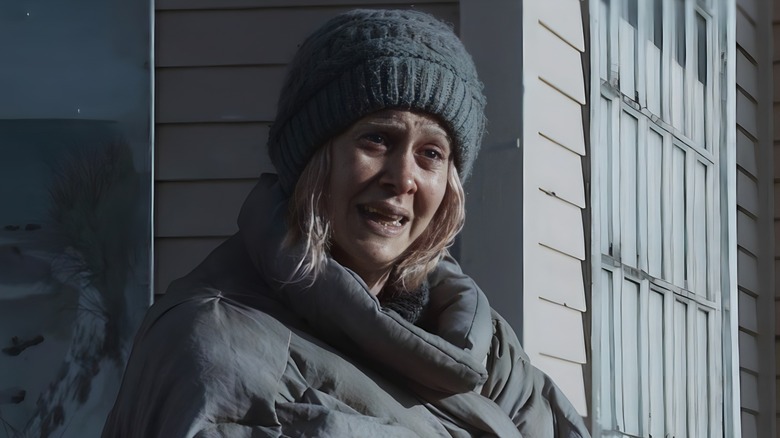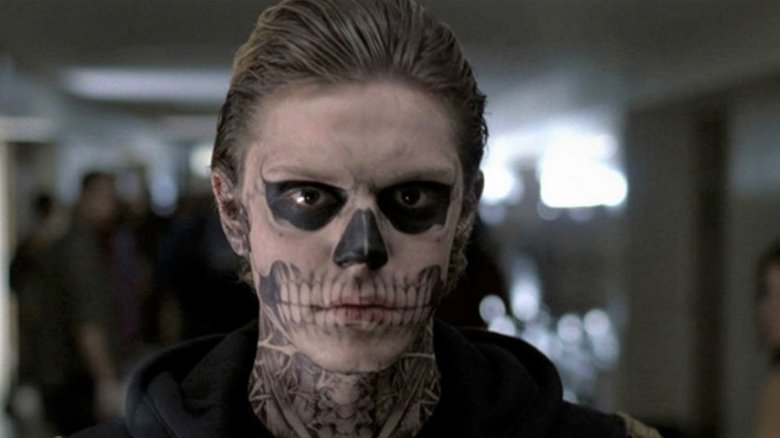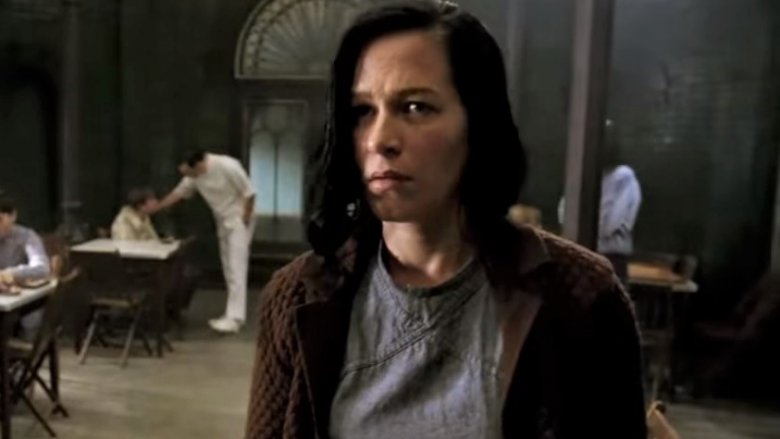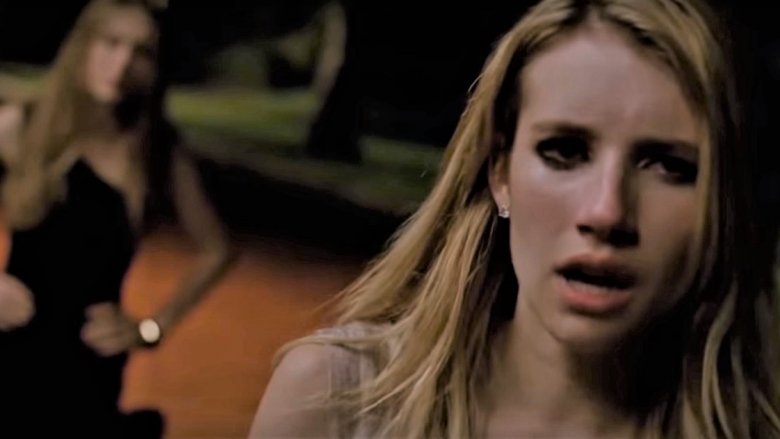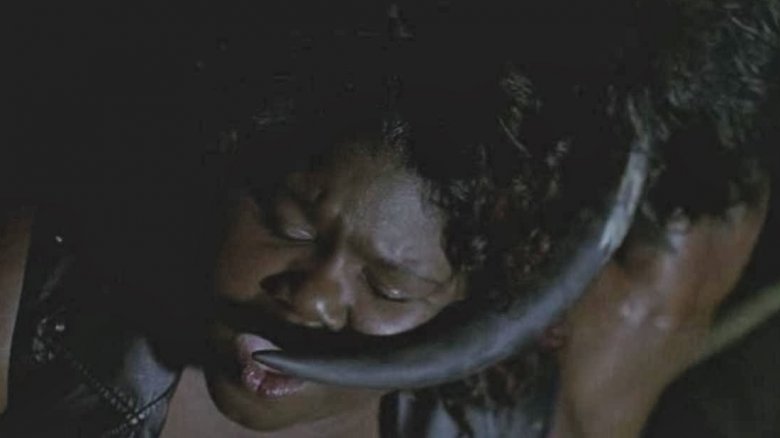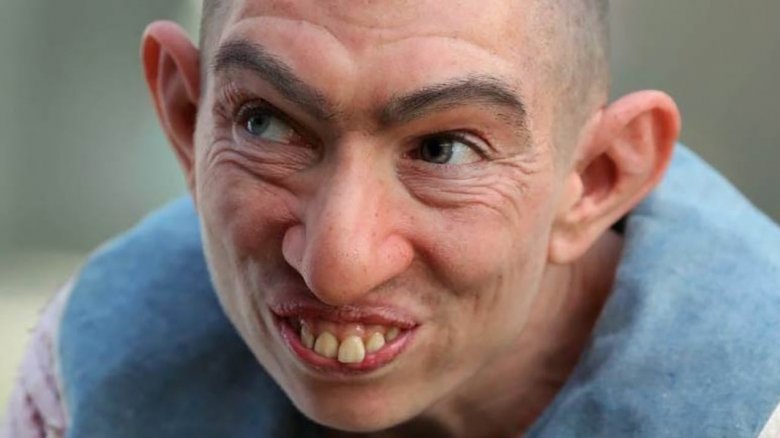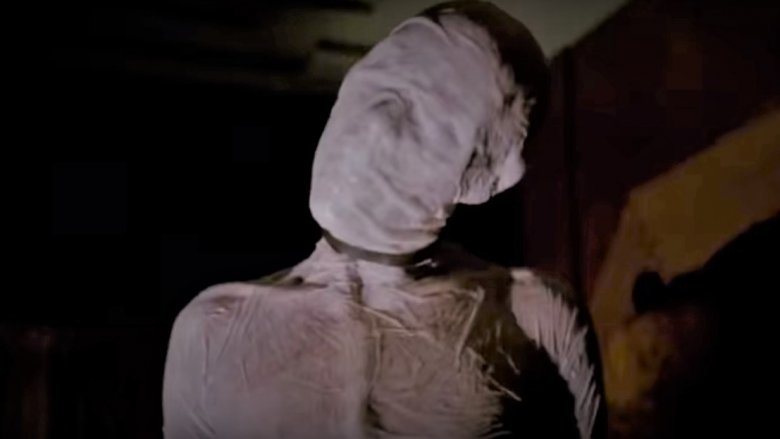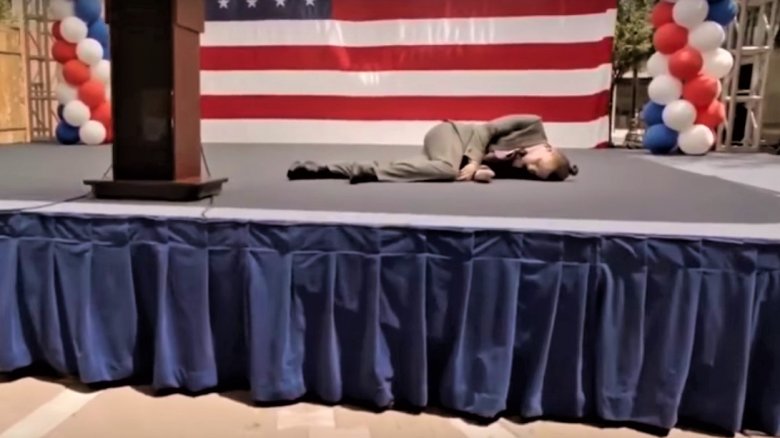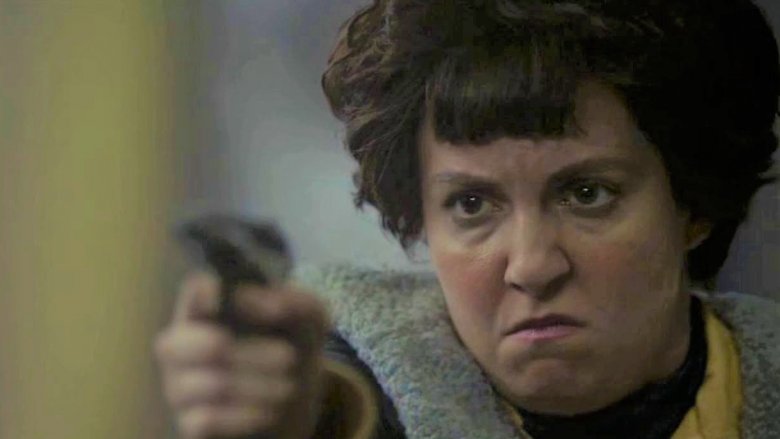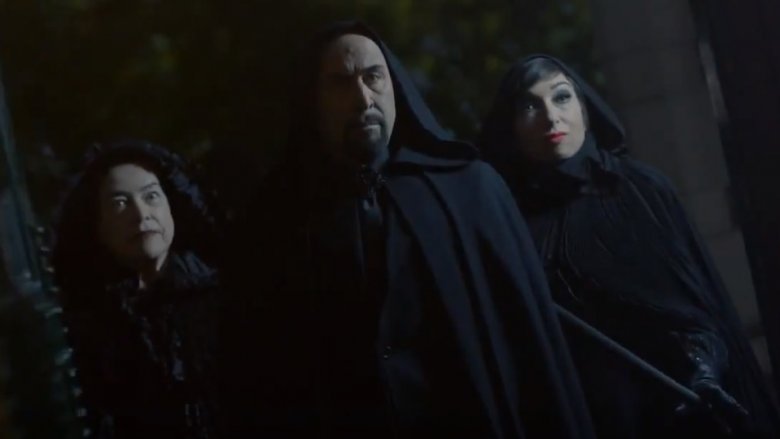The Most Controversial American Horror Story Moments
American Horror Story wouldn't be American Horror Story if it shied away from tackling controversial topics, but the hit FX show has been known to go to lengths that even its staunchest defenders can't deny are a tad extreme. We're now eight seasons into Ryan Murphy and Brad Falchuk's horror anthology series, and in that time we've seen our fair share of sex, violence and murder — quite often all at the same time. There have been countless moments that would have been seen as controversial in other shows, but when it comes to American Horror Story, something has to be pretty messed up to stand out from the week-to-week madness fans have become accustomed to.
Murphy and Falchuk have hit us with a handful of these truly WTF moments over the years, scenes that shocked even the most seasoned gorehounds and made some die-hard fans of the show turn their backs on it for good. From the mirroring of real-life violence to the rape culture that has seemingly become a part of the show's fabric, these are the most controversial American Horror Story moments yet. Be advised that even discussing these scenes can get a little intense.
Murder House's school shooting
Season One of American Horror Story (which was retroactively titled Murder House) was full of the all twisted violence that the show would go on to become infamous for, but there's one moment in the debut season that has always stood out as being particularly shocking. In the episode "Piggy Piggy," we see Tate Langdon (played by AHS stalwart Evan Peters) carrying out a school shooting, gunning down 15 of his fellow students. The on-screen massacre gave many viewers flashbacks to the horrific one that took place at Columbine High School years before.
"It's more than a little tasteless in a 'Hey, this, y'know, actually happened' kind of way," The Atlantic's Richard Lawson said at the time. "Obviously everything on the show if done in real life is insanely terrible, but this particular set piece seemed so deliberately exact. There was a particular event, or events, that they were trying to directly evoke and that's just cruel." There have been several shootings at U.S. high schools since that episode aired. Looking back at "Piggy Piggy" now, does it still have the same impact?
If anything, it's become even more controversial. When Decider's Kayla Cobb looked back at the episode in 2018, she said it was "difficult to deal with as a viewer, particularly when re-watching the episode this year." The fact that Tate's ghost was essentially given a happy ending when he briefly popped up in Apocalypse only added fuel to the flames.
Asylum's retelling of Anne Frank's story
Set in the 1960s, the second season of American Horror Story transported us to the fictional mental institution of Briarcliff Manor. Asylum followed the staff and occupants of Briarcliff, though one occupant in particular had many viewers outraged. In the episode "I Am Anne Frank – Part 1," a woman claiming to be Anne Frank showed up at Briarcliff, which rubbed Rolling Stone writer Halle Kiefer up the wrong way.
"Next time we see her, the woman is writing in her journal in the Briarcliff common room, because she's Anne Frank," Kiefer said after seeing the controversial episode. "Her journal is even named Kitty. Oh lord, Anne Frank was a real person. It just isn't done! Am I being too delicate about this?" Those defending the show argued that this wasn't really Anne Frank, just an ill lady who thought otherwise. This was the angle that Ryan Murphy took when quizzed about the inclusion.
"The Anne Frank thing was always interesting to me because after the war...there were many women who came forward after that diary and said, 'Well I'm the real Anne Frank,' and they were struck down," Murphy told Entertainment Weekly. "Many of them were found to be mentally ill and suffering from schizophrenia." But if this woman wasn't actually Anne Frank, how did she know that Dr. Arden was a Nazi war criminal? The viewer is supposed to leave never really knowing if she was actually Anne Frank.
Coven's rape scene
Rape is a taboo topic in television for obvious reasons, but Murphy and Falchuk have used it as a plot device in American Horror Story on several occasions, the most infamous of which remains the deeply disturbing gang rape that takes place in season 3, Coven. The victim is Madison Montgomery (a Lindsay Lohan sendup played by Emma Roberts), who is attacked by a group of frat boys at a party. The actress revealed that she didn't know a thing about the controversial scene until her script showed up.
"I was like, 'Oh my God, I'm so excited to be on this show, but geez this is heavy right out of the gate,'" Roberts told GQ. "I used to be so terrified of having to do scenes like that. I came onto this show thinking, 'You know what? There's going to be stuff that's twisted. I know there's going to be sex, but I'm just going to go for it because I have to get over it someday.'"
Of all the upsetting scenes in AHS history, this one was particularly difficult to watch because it showed the ordeal from the victim's point of view. It was a controversial moment in itself, but things got worse when it inspired real-life harassment of Roberts online. "It became clear that only harm can come from certain fans enjoying the sinister show when groups of them began cheering on the rape of Madison Montgomery," Bustle reported.
Coven's bestiality
Most seasons of AHS contain more than one controversial moment, but Coven really outdid itself. After the aforementioned rape of Madison Montgomery (who takes revenge by using her powers to flip the bus the frat boys are escaping in), the moment that stands out the most has to be the scene in which Montgomery's fellow witch Queenie (Gabourey Sidibe) has a gross sexual encounter of her own, though she does so of her own accord.
A scene involving a Minotaur sent to exact revenge on racist killer Madame LaLaurie (Kathy Bates) caused much disgust and outrage. The inclusion of Delphine LaLaurie (a real life New Orleans socialite who tortured and murdered her slaves) was a controversy in itself, but the question of whether or not the showrunners were right to use her was put to one side the moment the Minotaur meets Queenie. In an unexpected (even for American Horror Story) twist, she takes pity on the beast and decides to get down and dirty with it.
"Is this the most horrific episode of American Horror Story yet?" the Daily Mail asked. The British tabloid claimed that fans of the show had been "left shocked" by this moment of bestiality, but the one person that was totally cool with it was Sidibe herself. "I knew to say yes and to step out with faith and trust in Ryan and his entire production team," she told Parade. "I took the Minotaur by the horns."
Freak Show's freak show
Not everyone is repulsed by the so-called human oddities that ringmaster Elsa Mars (Jessica Lange) brings to small-town Florida in Freak Show (just ask the housewives paying good money for an "appointment" with Jimmy 'Lobster Boy' Darling), but most people are. Jimmy defends his fellow performers from the bigots they encounter on the show, but they weren't the issue — it was the treatment of the "freaks" by the showrunners that upset many disabled viewers.
In a piece he penned for The Guardian, journalist Howard Sherman asked readers if we should be scared of people who are different. "Some people in show business want you to be: the deeply unsettling ads for American Horror Story: Freak Show are determined to make you associate 'freaks' with something scary and strange," he said. Sherman expressed concern about the word "freak" making a comeback because of shows like AHS.
It could be argued that Freak Show paints an accurate picture of discrimination in the 1950s, but that argument doesn't hold up for Inverse's Caitlin Busch. "The history of 'freak shows' and the mistreatment of the physically disabled and the physically 'different' shouldn't be ignored as it often is, but it also shouldn't be sexualized, wrapped up in a pretty dress, and cranked up to 11 for the amusement of the masses," she said. "That's what Freak Show did to its characters, and it is, to my knowledge, some of the worst ableism on television in the 21st century."
Hotel's Addiction Demon
When Cosmopolitan's Danielle Henderson shared her thoughts on American Horror Story: Hotel, she warned her readers that the fifth season of the show took things to a whole new level. "I rarely do trigger warnings, but since Ryan Murphy insists on jamming his shows full of rape scenes, I have to let you know that the one in AHS: Hotel is more violent than ever before," she said. It wasn't the first AHS rape scene to cause controversy, but it was the most bizarre and brutal one yet.
Henderson took particular issue with a scene in the season premiere in which a heroin user named Gabriel checks into the Hotel Cortez to shoot up and is sodomized by the Addiction Demon, a monstrous entity who owns the world's deadliest sex toy. "To say this scene was disturbing is an understatement—Gabriel goes to this hotel to get high and ends up on his stomach being raped by something wearing a sharp, metal, drill bit-like device."
The Parents Television Council attacked the episode for what it described (via The Hollywood Reporter) as an "unbelievably explicit combination of sex and violence." In a letter to subscribers, president Tim Winter called what he'd seen in the season 5 opener the "most vile and shocking content I've ever seen on TV. Ever. Most Americans have no idea this is primetime fare on advertiser-supported basic cable."
Cult's mass shooting
Murphy and Falchuk got political AHS-style during season 7, parodying the events of the 2016 presidential election in typically brutal fashion. American Horror Story: Cult follows Kai Anderson (Evan Peters), a mentally unstable man who forces his way onto the political landscape using a potent mixture of scare mongering and murderous clowns. The violent cult leader stages a shooting at his own rally to sway public opinion in his favor, a sensitive scene to film at the best of times, but even more so considering it was right after a real-life shooting.
On the night of October 1, 2017, the deadliest mass shooting in modern U.S. history took place in Las Vegas. On October 10, the episode "Mid-Western Assassin" aired, which included the aforementioned killing spree at Anderson's rally. The version of the episode that was shown by FX that night was cut down out of respect, but no matter how many dead people they replaced with shots of the American flag waving in the wind, it was still a highly controversial moment of television, given the timing.
"The need to edit out a moment of violence that now feels all too real is all the more chilling when you consider Cult is acting as a giant metaphor (and some could say, as a giant mirror held up to) the post-election era," AV Club's Molly Horan wrote the same night the controversial episode dropped.
Cult's Lena Dunham performance
Another much-talked-about season 7 moment came by way of Lena Dunham, who is no stranger to controversy. Dunham became the new darling of the indie scene in 2010 when she wrote, directed and starred in Tiny Furniture, and two years later she came to the attention of wider audiences via her HBO show, Girls. She was hailed as a new voice for Millennials, but in recent years people have started to turn against her brash brand of humor. "What was once sold as quirky and individualistic is now attacked as tone-deaf and pampered, a by-product of cushy white privilege," Vanity Fair's James Wolcott said in 2018.
There are only so many times you can say inflammatory things and get away with it, and by the time Dunham appeared on Cult she was already on thin ice. She portrayed Valerie Solanas (the radical feminist who attempted to kill Andy Warhol in 1968) on the show, delivering a line that had her haters up in arms. Solanas claims that women do not rape their daughters, which led numerous Twitter users to point out that Dunham had essentially admitted to sexually assaulting her younger sister.
"Basically, anything a sexual predator might do to woo a small suburban girl, I was trying," she revealed in her memoir (via The Guardian). Dunham admitted to touching her sibling in private places out of curiosity, but she was "dismayed" to learn that critics had been interpreting her actions as abuse.
Apocalypse's Satanic panic
You'd think the coming of the Antichrist would be heralded as good news by the Church of Satan, but the organization isn't at all happy about the most recent season of American Horror Story. Previous seasons collide in Apocalypse, with characters from Murder House and Coven featuring prominently. We are reintroduced to Michael Langdon (Cody Fern), a harbinger of the End of Days fathered by the ghost of high school shooter Tate Langdon back in season one. It's not Michael that the Satanists have a problem with, however — it's the show's portrayal of their church's late founder.
Known to his followers as the Black Pope, Anton LaVey created the Church of Satan in the swinging '60s, using the sexual liberation of the day to his advantage. He attracted celebrities like Jayne Mansfield, Sammy Davis Jr., and even Liberace to his masses. Conspiracy theorists claim that the devil had a hand in Mansfield's fatal car crash in 1967, but there's no evidence to suggest that LaVey (real name Howard Levey) ever killed anyone.
In the show, however, LaVey (played by modern-day doppelganger Carlo Rota) commits a human sacrifice for Langdon. This is just one of the many inaccuracies relating to the Church of Satan, according to its official Twitter account. "Anton LaVey didn't believe in Christ or an Anti-Christ and sacrifice plays no role in Satanism. Lazy writers appropriated his name and image for their Devil worship drivel [which] is unimpressive and boring."
